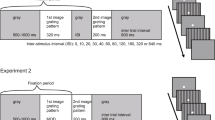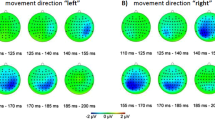Abstract
The perception of the displacement of luminance-defined contours (i.e., first-order motion) is an important and well-examined function of the visual system. It can be explained, for example, by the operation of elementary motion detectors (EMDs), which cross-correlate the spatiotemporal luminance distribution. More recent studies using second-order motion stimuli, i.e., shifts of the distribution of features such as contrast, texture, flicker, or motion, extended classic concepts of motion perception by including nonlinear or hierarchical processing in the EMD. Smooth-pursuit eye movements can be used as a direct behavioral probe for motion processing. The ability of the visual system to extract motion signals from the spatiotemporal changes of the retinal image can be addressed by analyzing the elicited eye movements. We measured the eye movement response to moving objects defined by two different types of first-order motion and two different types of second-order motion. Our results clearly showed that the direction of smooth-pursuit eye movements was always determined by the direction of object motion. In particular, in the case of second-order motion stimuli, smooth-pursuit did not follow the retinal image motion. The latency of the initial saccades during pursuit of second-order stimuli was slightly but significantly increased, compared with the latency of saccades elicited by first-order motion. The processing of second-order motion in the peripheral visual field was less exact than the processing of first-order motion in the peripheral field. Steady state smooth-pursuit eye speed did not reflect the velocity of second-order motion as precisely as that of first-order motion, and the resulting retinal error was compensated by saccades. Interestingly, for slow second-order stimuli we observed that the eye could move faster than the target, leading to small, corrective saccades in the opposite direction to the ongoing smooth-pursuit eye movement. We conclude from our results that both visual perception and the control of smooth-pursuit eye movements have access to processing mechanisms extracting first- and second-order motion.
Similar content being viewed by others
Author information
Authors and Affiliations
Additional information
Received: 26 August 1996 / Accepted: 8 November 1996
Rights and permissions
About this article
Cite this article
Butzer, F., Ilg, U. & Zanker, J. Smooth-pursuit eye movements elicited by first-order and second-order motion. Exp Brain Res 115, 61–70 (1997). https://doi.org/10.1007/PL00005686
Issue Date:
DOI: https://doi.org/10.1007/PL00005686




